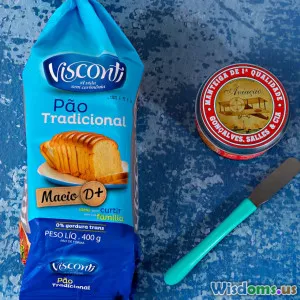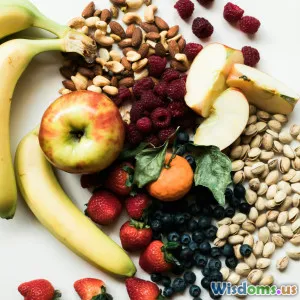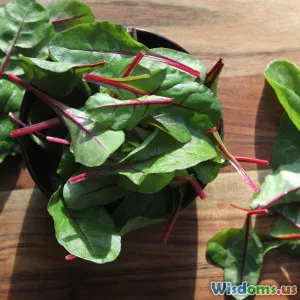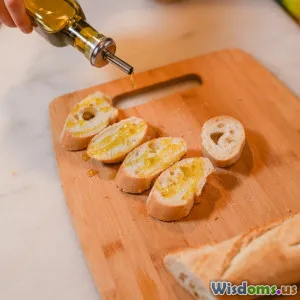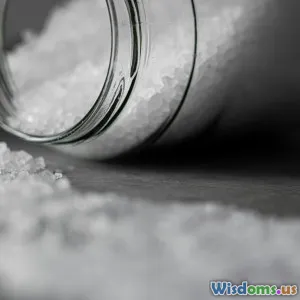
How I Reduced Hidden Sodium by Reading Food Labels Closely
9 min read Discover how careful food label reading helped me slash hidden sodium and improve health. (0 Reviews)
How I Reduced Hidden Sodium by Reading Food Labels Closely
Sodium is an essential mineral our bodies need, but too much of it can silently wreak havoc on heart health and blood pressure. Despite countless public health campaigns urging us to eat less salt, most people consume far above the recommended daily limits — largely because sodium is hidden in unexpected places, tucked away inside processed foods. I was no exception, enjoying seemingly “healthy” convenience foods while unknowingly consuming alarming amounts of sodium daily.
This journey started to change when I took the bold step to scrutinize food labels on every item I purchased. What I discovered opened my eyes to a hidden world of salt-laden ingredients masquerading under different names. This detailed reading not only helped me slash my hidden sodium intake significantly but also enlightened me on making better, more informed food choices. In this article, I share my experience, backed by facts and practical tips, to empower you to reduce hidden sodium through smarter label reading.
Understanding Hidden Sodium: Why Labels Matter
Most people think sodium equals table salt, but this mineral appears under numerous names on ingredient lists: monosodium glutamate (MSG), sodium bicarbonate (baking soda), sodium nitrate, disodium phosphate, and many more. Even foods marketed as "low-fat" or "healthy" can contain surprisingly high sodium levels as flavor enhancers or preservatives.
According to the CDC, the average American adult consumes about 3,400 mg of sodium daily — well above the American Heart Association’s recommended maximum of 2,300 mg, ideally aiming for 1,500 mg for better heart health. High sodium intake is linked to hypertension, stroke, kidney disease, and heart failure. Unfortunately, over 70% of our sodium comes from packaged, restaurant, and processed foods, not the salt shaker.
Food labels offer the first line of defense against hidden sodium. Understanding and decoding them is critical because:
- Sodium content is listed in milligrams (mg) per serving — scrutinizing serving sizes helps avoid underestimating intake.
- Ingredients are listed in descending order by weight — seeing various sodium-containing additives can send red flags.
- Nutrition Facts Panel highlights % Daily Value (%DV), aiding in rapid assessment; anything over 20% per serving is high.
My Personal Approach: Step-by-Step Label Investigation
Step 1: Educating Myself on Sodium Terms
At first, sodium-containing ingredients seemed like a foreign language filled with "disodium" and "sodium phosphate." I compiled a personal cheat sheet listing common sodium sources such as:
- Sodium chloride (table salt)
- Monosodium glutamate (MSG)
- Sodium bicarbonate (baking soda)
- Sodium nitrate/nitrite (cured meats)
- Disodium guanylate/inosinate (flavor enhancers)
Understanding these terms empowered me not just to look for only “salt” but to consider every sodium form.
Step 2: Paying Attention to Serving Size
Many labels disguise high sodium levels by showing small serving sizes. For example, a single serving of canned soup might be 1 cup, but most adults eat about 2 cups — doubling the sodium intake unnoticed. I began adjusting nutrition info according to realistic portions.
Step 3: Comparing Different Brands and Products
Buying the same veggie chips? Checking different brands revealed some packaged options with double or triple the sodium content. Opting for "lowest sodium" or "no added salt" labels whenever possible made a tangible difference.
Step 4: Cooking from Scratch When Possible
Realizing processed sauces, seasoning mixes, and ready-meals were dumping ground for sodium, I experimented with homemade alternatives using fresh herbs and lemon instead of salt-heavy seasoning packets.
Eye-opening Examples from My Grocery Cart
Example 1: Bread — A Surprising Sodium Source
I was shocked to learn that a plain sandwich bread slice can contain 150-200 mg of sodium, meaning a sandwich with 2-3 slices already adds 300-600 mg, about 15-25% of the daily recommendation! Reducing sodium in bread and switching to artisanal or homemade bread with lower salt balanced out my daily total.
Example 2: Breakfast Cereals
While cereals might seem low in salt, many have added sodium to enhance flavor and shelf life. Choosing unsweetened, low-sodium oats or cereals reduced sodium and sugar simultaneously.
Example 3: Condiments and Dressings
Salad dressings, soy sauce, ketchup, and pickles can pack an unexpectedly large sodium punch. By choosing vinegar-based dressings and low-sodium soy sauce or diluting them, I lowered hidden salt intake further.
The Impact: Quantifiable Reduction and Health Changes
With consistent label reading and swapping high-sodium products for low-sodium counterparts, I reduced my daily sodium intake from roughly 3,200 mg to around 1,800 mg within three months. Health improvements were noticeable:
- Blood pressure readings dropped by 8 mm Hg systolic on average.
- Reduced symptoms of bloating and water retention.
- A general sense of increased energy and wellbeing.
My experience aligns with studies showing that reducing sodium intake by 1,000 mg daily can lead to significant decreases in blood pressure and reduce cardiovascular risk.
Practical Tips for You to Reduce Hidden Sodium
-
Use Apps and Online Databases: Tools like the USDA FoodData Central or apps such as MyFitnessPal help check exact sodium content for products on the go.
-
Look for “Low Sodium” Labels: Products labeled “low sodium” contain 140 mg or less per serving, per FDA guidelines.
-
Focus on Fresh and Whole Foods: Fresh fruits, vegetables, beans, and lean meats naturally have little sodium.
-
Be Wary with Restaurant and Fast Foods: Many fast-food items contain excessive sodium; request nutritional info and choose wisely.
-
Rinse Canned Vegetables and Beans: Reduces sodium content by washing off excess salt.
-
Experiment with Spices and Herbs Instead of Salt: Garlic, rosemary, lemon zest, and pepper add flavor without sodium.
-
Cook at Home More Often: Homemade meals give full control over sodium.
Conclusion: Empowerment Through Awareness
The journey to reducing hidden sodium started with a simple habit — reading food labels closely. Understanding common sodium additives, deciphering serving sizes, and making mindful substitutions effectively lowered my sodium intake, bringing measurable health benefits. This practice can transform your eating habits too.
No diet needs to taste bland to be heart-healthy. With keen awareness and smarter shopping decisions, you can reveal hidden sodium hiding in everyday foods and reclaim your health one label at a time.
Take action today: next time you pick up that packaged item, be a detective — read the label thoroughly and make choices your heart will thank you for.
References:
Centers for Disease Control and Prevention (CDC). "Sodium and Food Sources."
American Heart Association. "How Much Sodium Should I Eat Per Day?"
USDA FoodData Central.
Mente A, O'Donnell M, et al. "Associations of urinary sodium excretion with cardiovascular events." N Engl J Med. 2014.
Rate the Post
User Reviews
Popular Posts










